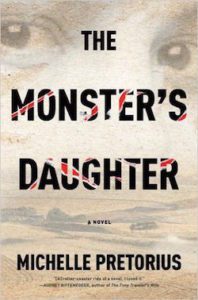
Alet’s stomach turned when she saw it. The body lay curled in a fetal position, its hands balled into fists in front of its face, like a boxer readying for a fight. It had been burned, the flesh so charred that it looked as if the slightest breeze might lift the ashes into the air and destroy its integrity.
In her debut novel, The Monster’s Daughter, Michelle Pretorius weaves a small town murder mystery into the fabric of a century-long struggle power struggle for the soul of South Africa, with elements of science fiction, family drama, and historical epic. It’s an ambitious book, and Pretorius is up to the task, creating a story that is equal parts propulsive and thought-provoking.
Disgraced police officer Alet Berg has been banished to the small, seemingly sleepy town of Unie in South Africa. She’s stuck directing traffic until she figures out a way to get back to her real life as an elite special forces officer in Johannesburg. Her opportunity comes when a gruesome murder with no clear leads is committed within the Unie jurisdiction. Although she is not officially on the case, Alet begins investigating the crime using the resources and connections she accrued in Johannesburg, as well as her family name—her father was a legendary retired police officer. Though it’s clear her investigation is causing trouble, Alet has a single-minded focus on her goal. She cares about justice, and maybe her own ambitions, more than the ramifications of her actions.
Meanwhile, back in the late 1800s, this desolate and hardscrabble country is facing an existential crisis. The Boer War, between the British and the Dutch-descended Afrikaners, has placed native South Africans under the oppressive yoke of both groups. Ostensibly a fight for control of the country’s gold, the war damages the psyche of the country and its inhabitants. Atrocities are committed by both sides, and good people become ineffectual bystanders or reluctant participants. One group of Afrikaner girls is captured and subjected to abuse at the hands of a brutal mercenary and a doctor whose genetic experimentations foreshadow those of Joseph Mengle. The results of his experimentations are Tessa and Ben, two unnaturally long-lived children with strikingly pale hair and eyes.
The rest of the novel flashes among Alet, Tessa, Ben, and a few side characters. Alet is initially focused on the murder, but she slowly begins to realize that the case reverberates through the past and has ties that may be uncomfortably close to home. Tessa is adopted by an interracial family and sees firsthand the destructive nature of racism, classism, and nationalism. She is forced to watch as her loved ones are stripped away from her while she continues to live, despite the senseless violence that never seems to change or end. Ben, after a disorienting upbringing in a mental institution, becomes one of the greatest perpetrators of that violence, believing that he and Tessa belong to a superior race.
Despite the vast scope of the story, The Monster’s Daughter never feels convoluted or overstretched. Almost every storyline pays off and—more impressively—feels like it belongs in the same narrative web. A black man seeking a country where he’s treated with basic human rights seems far removed from a white cop trying to restore her good name, but Pretorius makes their disparate tales resonate in important ways.
What really elevates The Monster’s Daughter is its sense of place and history. The characters spend time in fancy hotel bars, deserted expanses of wilderness, and city slums, in time periods ranging from the late 1800s to modern day. Each setting feels distinct and authentic. Pretorius is at her most poetic when describing the country itself:
The valley below them, caught between jagged black mountains enveloped by fog, stretched out to where blue sky and green earth were separated by a thin line of nothing. At the foot of the cliffs, brown workers picked peaches in orchards, led sheep to pasture, and tilled the red earth.
One disappointment is that Pretorius tends to hit her marks a little too hard. She tends to take nuanced implications—about being marginalized, or the effects of sexism and racism—and state them explicitly, undercutting the power of the prose. There are also a few storylines that get brought up without seeming to go anywhere, including a questionable police shooting. But these are minor flaws in an impressive work of storytelling.
The Monster’s Daughter blends a rousing plot with deep, multifaceted characters, and it constantly pushes for deeper meaning beyond the surface. Pretorius aims high, and the results will likely have you thinking about the lingering traumas of the past, the toxic effects of marginalization, and the cost of moral and immoral actions long after you set down the book.




